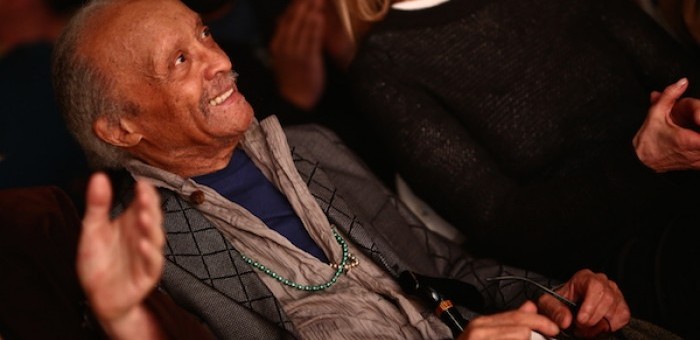Oct 28, 2025 10:47 AM
In Memoriam: Jack DeJohnette, 1942–2025
Jack DeJohnette, a bold and resourceful drummer and NEA Jazz Master who forged a unique vocabulary on the kit over his…

Cecil Taylor, the subject of a career retrospective at the Whitney Museum in New York, listens to a performance there on April 16.
(Photo: © Paula Court)On the opening day of Open Plan: Cecil Taylor, muttering had begun from assembled fans that Taylor—who was being feted with a 10-day exhibit and performance series at the Whitney Museum of American Art in New York City—wouldn’t be playing the piano, but would instead be reading his decidedly abstract poetry. Rumors swirled, including one that he would just be dancing, or that at age 87, he perhaps could no longer dance.
If there’s a dubious reputation that precedes the free-jazz legend, it’s one he’s contributed to, with his notoriously late arrivals. But it’s not one he seemed intent on living up to this time around.
The opening night saw him in fine form, playing as beautifully as he ever has with dancer Min Tanaka and percussionist Tony Oxley playing electronics, and then in a larger and more raucous group. It was the only announced performance by the master but of course rumors abounded that he’d be “sitting in” with bands playing in his honor.
Those tribute concerts—a part of the museum’s “Open Plan” series, which has included exhibitions dedicated to artists Lucy Dodd, Andrea Fraser and Michael Heizer—were held on the expansive, open fifth floor of the museum’s new home in the fashionable Meat Packing District, and the pianist was omnipresent even when he wasn’t in the building.
A large screen suspended in the middle of the room showed a film (on a constant loop) of Taylor playing and dancing. Other, smaller screens continuously played concert excerpts. Listening stations and memorabilia collections lined the space.
Saturday, April 16, was the first full day of events, with an informative lecture about Taylor’s use of dance taking place that afternoon. That speech was followed by a solo performance by Tanaka, at which an inadvertent soundtrack was provided by drummer Andrew Cyrille, bassist William Parker and trumpeter Enrico Rava, who were sound-checking nearby for their own concert later that evening. (Click below for slideshow.)
Shortly after 7 p.m., Cyrille took the stage to play a solo set, beginning in front of the kit, hunched over the bass drum and playing it with sticks (or his hand when one went errant). He circled the kit in a slow dance, playing stands and the stage in quick bursts, finally sitting down and unleashing a cleansing wash of cymbals.
He then fixated on the natural slap-back reverberation of the cavernous room, letting repeated snare cracks bounce back and forth. He continued to play in short themes and variations, occasionally glancing at a score, introducing new phrases and dynamics every few minutes, kneading them and setting them aside until, eventually, he began reciting the names of letters between the musical phrases: “C-E-C-I-L,” and then “T-A-Y-L-O-R,” announcing the arrival of the diminutive man of the hour who was now sitting in the front row, beaming.
Rava led the trio set that followed, with Parker—his bass adorned with black and red paint—running quick figures and Cyrille (having taken only a short break after his solo set) setting a light, quick pace. There was no searching for form; they locked in immediately, a sure sign of free-improvisation proficiency.
They didn’t attempt to upend the horn trio format. The rhythm section held fast, generally keeping a tight read on each other, while Rava embraced the soloist role (even if, from another vantage, all three were soloing simultaneously).
Together they made their way into some uptempo free-bop. Parker took a couple of nice solos with Cyrille augmentation, the first punctuated by the bending and snapping of a small cymbal and the second by the drummer’s mouth percussion.
Meanwhile, at the rear of the stage, sat Taylor’s signature Bösendorfer piano, the lid propped up and microphones in place, but not to be attended to by the pianist seated in the front row—at least not on this night.

Jack DeJohnette boasted a musical resume that was as long as it was fearsome.
Oct 28, 2025 10:47 AM
Jack DeJohnette, a bold and resourceful drummer and NEA Jazz Master who forged a unique vocabulary on the kit over his…

D’Angelo achieved commercial and critical success experimenting with a fusion of jazz, funk, soul, R&B and hip-hop.
Oct 14, 2025 1:47 PM
D’Angelo, a Grammy-winning R&B and neo-soul singer, guitarist and pianist who exerted a profound influence on 21st…

To see the complete list of nominations for the 2026 Grammy Awards, go to grammy.com.
Nov 11, 2025 12:35 PM
The nominations for the 2026 Grammy Awards are in, with plenty to smile about for the worlds of jazz, blues and beyond.…

Drummond was cherished by generations of mainstream jazz listeners and bandleaders for his authoritative tonal presence, a defining quality of his style most apparent when he played his instrument unamplified.
Nov 4, 2025 11:39 AM
Ray Drummond, a first-call bassist who appeared on hundreds of albums as a sideman for some of the top names in jazz…

Jim McNeely’s singular body of work had a profound and lasting influence on many of today’s top jazz composers in the U.S. and in Europe.
Oct 7, 2025 3:40 PM
Pianist Jim McNeely, one of the most distinguished large ensemble jazz composers of his generation, died Sept. 26 at…





